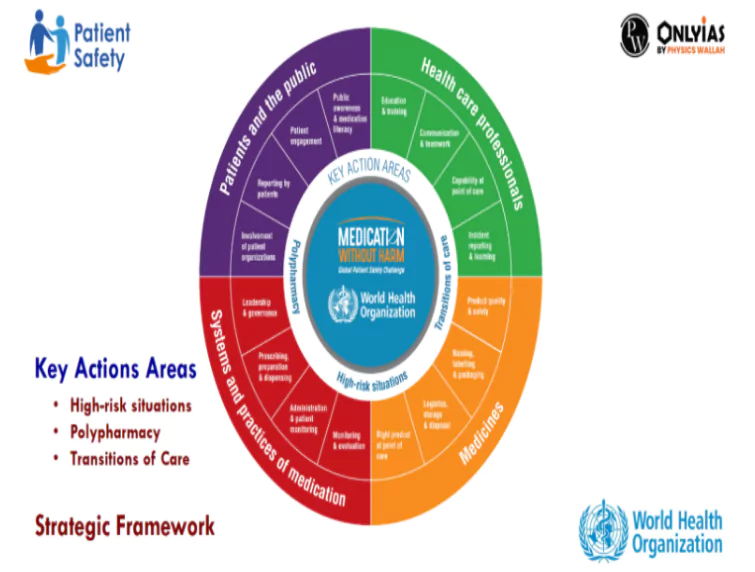Context
A Patient Safety Rights Charter was launched by WHO at the Global Ministerial Summit on Patient Safety.
WHO launches first ever Patient Safety Rights Charter
- It is the first ever charter released to establish patients rights in the context of safety and aims to support various stakeholders in formulating the legislation, policies and guidelines needed to ensure patient safety.
- Improving patient safety through systemic and systematic action is a global priority identified in the World Health Assembly resolution 72.6 – Global action on patient safety and the Global Patient Safety Action plan 2021-2030.
- The Charter covers 10 patient safety rights necessary to mitigate risks and prevent undue harm.
The Sixth Global Ministerial Summit on Patient Safety:
- Host: It will be hosted by the Government of Chile in Santiago, Chile on 17–18 April 2024.
- Slogan: Bringing and sustaining changes in patient safety policies and practices
- Objective: To facilitate discussions amongst stakeholders (ministers, healthcare leaders and patient advocates) on how to bring change and sustain changes in patient safety policies and practices, the challenges and opportunities while implementing the Global Patient Safety Action Plan.
|
What is meant by Patient Safety Rights?
- Patient safety speaks to the first, fundamental principle of health care – ‘Do no harm’.
- It refers to the processes, procedures and cultures established in health systems which promote safety and minimise the risk of harm to patients.
- Patient safety can be seen as an indicator of countries’ broader commitment to respect, protect and fulfil health-related human rights and assuring patient safety is a critical component needed to achieve the Sustainable Development Goals.
Enroll now for UPSC Online Course
Significance of the Patient Safety Rights Charter
- Reform health care systems: The charter will serve as a key resource in assisting countries to integrate essential concepts such as patient and family engagement, equity, dignity, and access to information into their health care systems.
- To deliver the right to health: 1 in every 10 patients experience harm in healthcare, about 50% of this harm is preventable. The charter will guide the health care system to prevent the avoidable errors.
National Patient Safety Implementation Framework 2018-2025
- Goal: It is to improve patient safety at all levels of health care across all modalities of health care provision, including prevention, diagnosis, treatment and follow up within overall context of improving quality of care and progressing towards Universal Health Care.
- NPSIF applies to national and sub-national levels as well as to public and private sectors.
- Objectives: Establishing institutional framework/mechanisms; assessment and reporting of adverse events; competent health workforce; infection prevention and control; safety in programmatic and clinical domains and patient safety research.
- It is fully aligned with ‘Regional Strategy for Patient Safety in the WHO South-East Asia Region (2016-2025)’ endorsed by the 68th Regional Committee of WHO South-East Asia Region
|
- To avoid preventable harm: Patient safety can be compromised due to avoidable errors such as unsafe surgical procedures, medication errors, mis- or late diagnosis, poor injection practices, unsafe blood transfusion and the onset of life-threatening infections such as sepsis and other health care-associated infections.
- Patient centered healthcare systems: The Charter will provide healthcare workers, healthcare leaders and governments with the tools to build patient-centred healthcare systems, improving patient safety and reducing the risk of harm.
- A safety language for patients: The charter will provide patients with language to advocate for themselves in healthcare settings, and will facilitate continued collaboration between patients, their families and caregivers, communities and health systems.
Challenges for patient safety in India
- Limited resources: Participants described poor access to supplies, inadequate staffing levels, and poor infrastructure threatening patient safety resulting in cross-infection taking place in general wards.
- There is no system of reporting Hospital Administered Infection at any level and there is no authority in place to collect, analyse and report HAI at country level.
- Health care delivery systems: The health care delivery system is fragmented and their is absence of a quality assurance system for drugs with drug response serving as the only indicator of quality.
- Professional culture: Their is a punitive approach to adverse events, and a rigid workplace hierarchy with the doctor unduly concerned more about his safety rather than the patient safety.
- Patient education: Patients expectations and behaviors were safety barriers, and led to overuse of medicines, the use of counterfeit or expired medications, over the counter treatments.
- Inadequate Training of the support staff like nurses and ward boys in clinical practices.
- Poor Sanitation: It results in hospital derived Infection and ineffective disposal of medical waste can result in Anti microbial resistance etc.
The 10 Fundamental Patient Safety Rights:

- Timely, effective and appropriate care.
- Safe health care processes and practices.
- Qualified and competent health workers.
- Safe medical products and their safe and rational use.
- Safe and secure health care facilities.
- Dignity, respect, non-discrimination, privacy and confidentiality.
- Information, education and supported decision making.
- Access medical records.
- To be heard and fair resolution.
- Patient and family engagement.
|
Also Read: Cancer Prevalence In India
